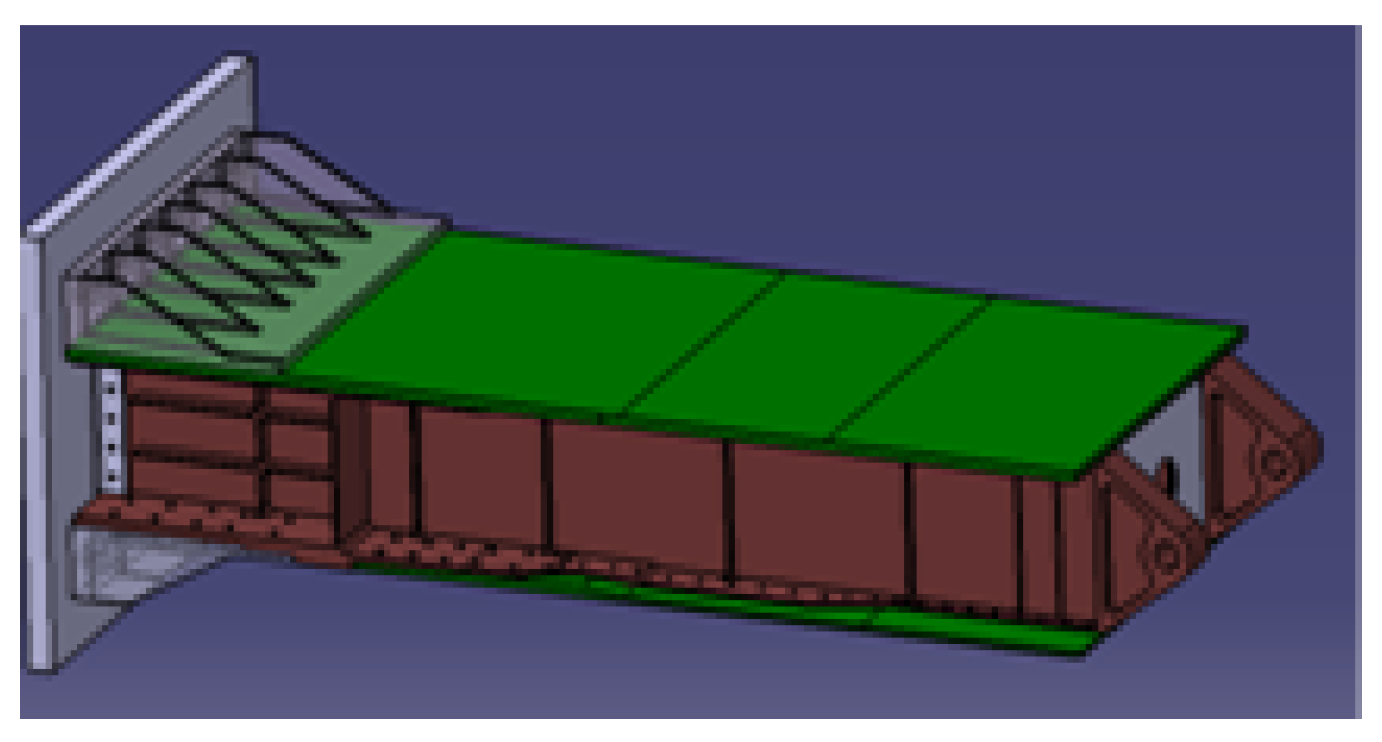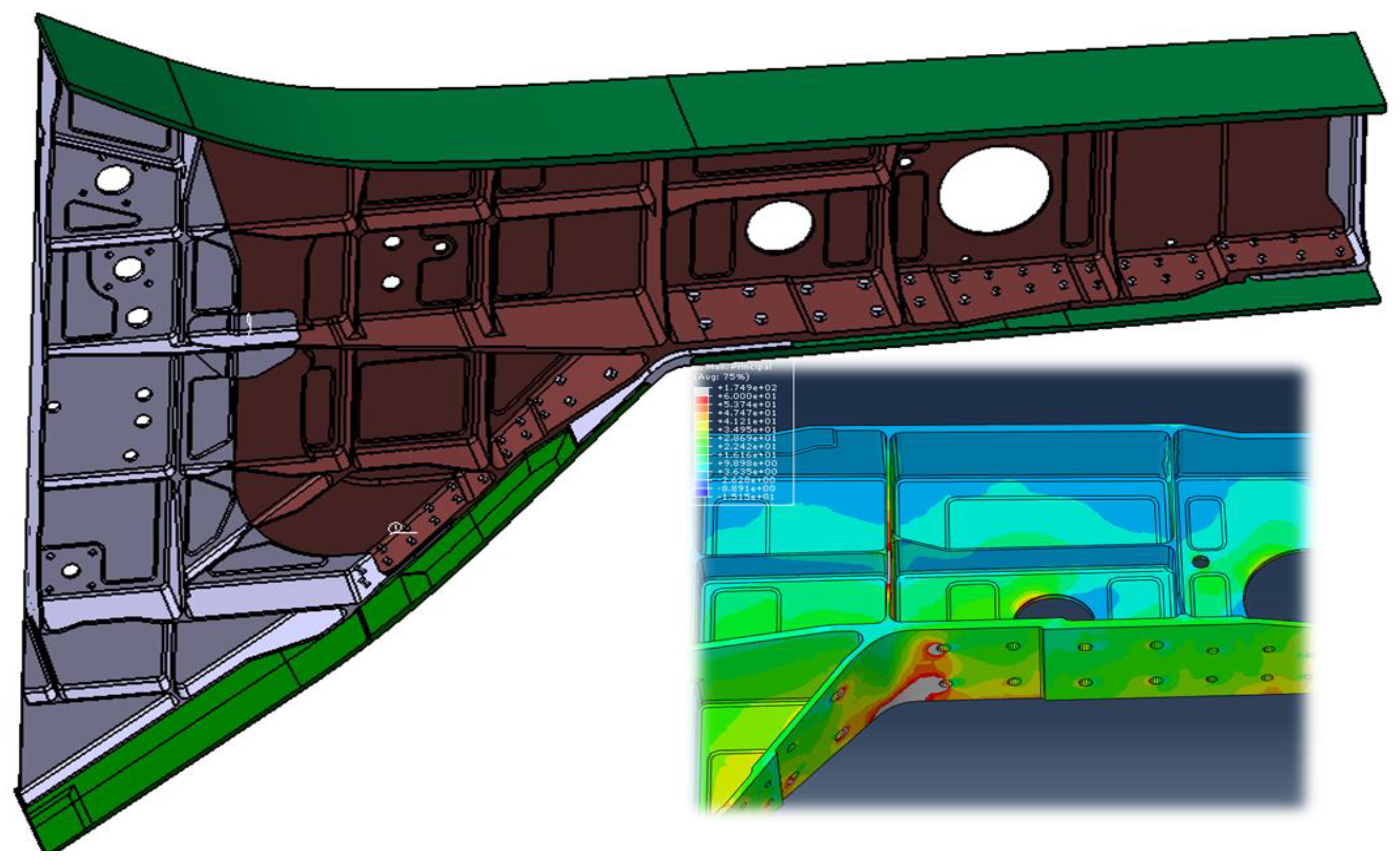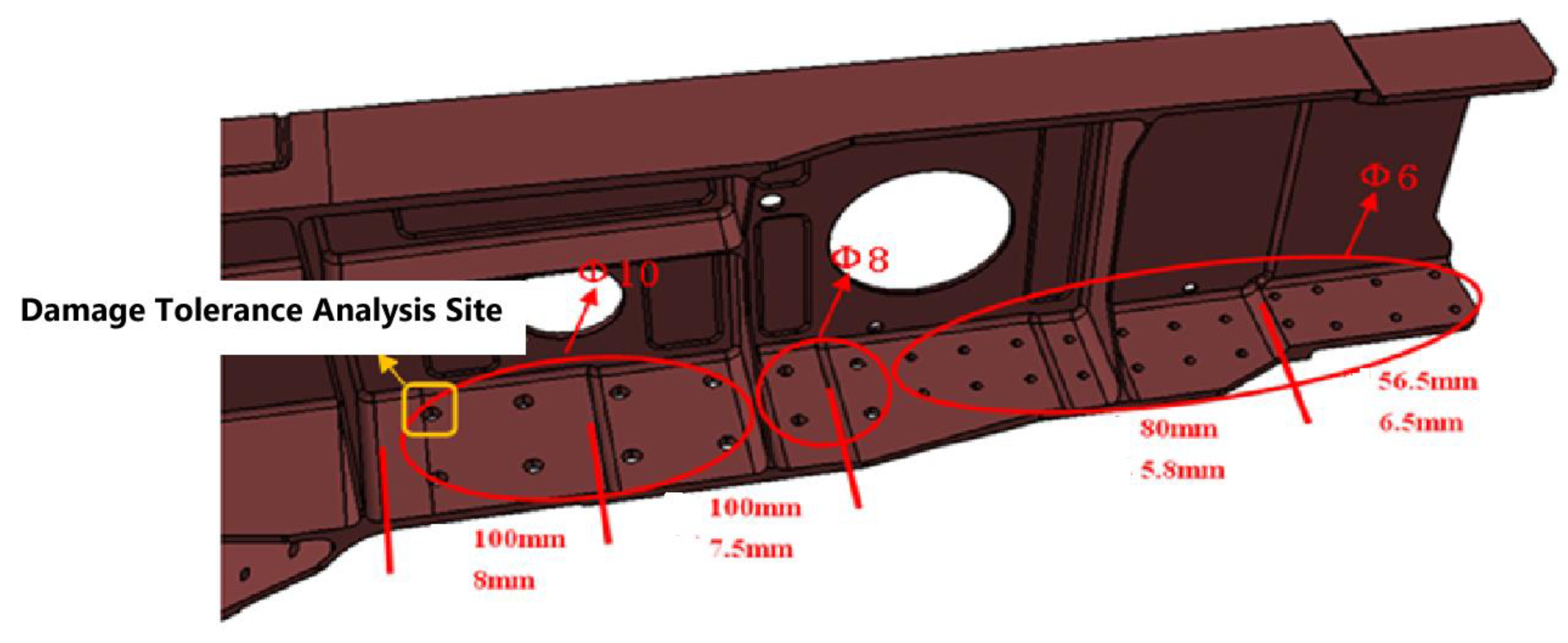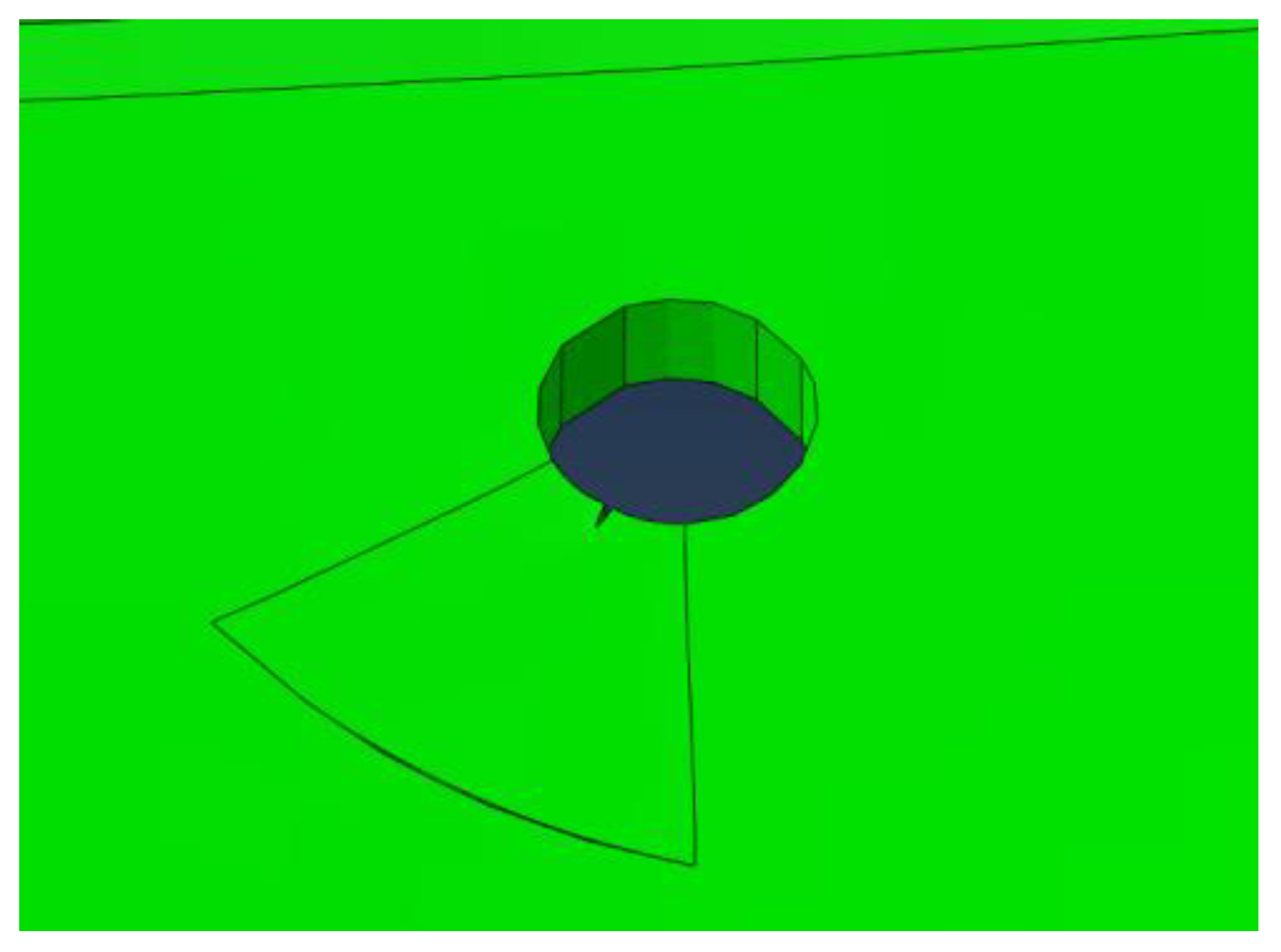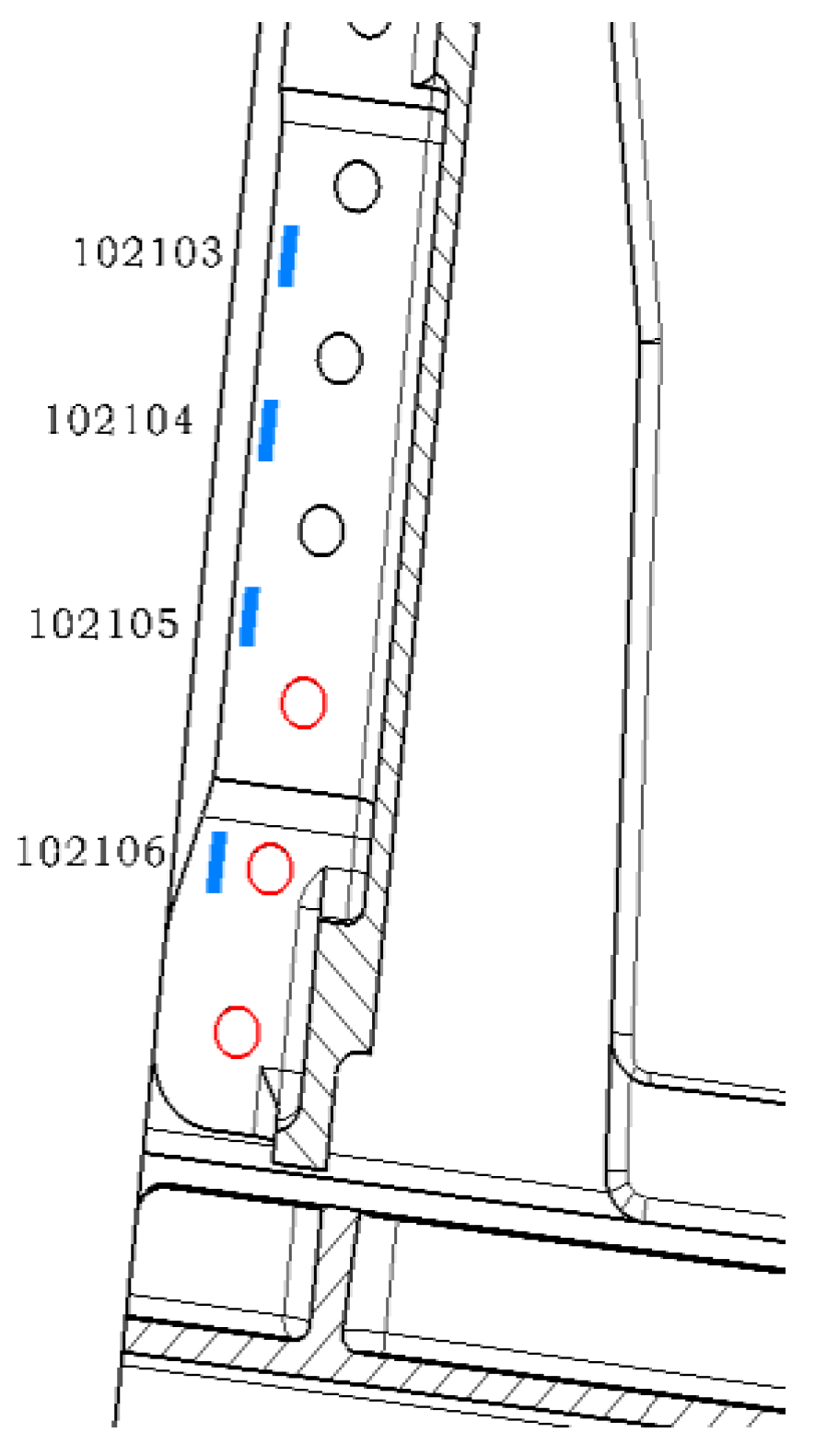1. Introduction
The safety of aircraft is the primary concern of the aviation industry. With the trend of large, lightweight, and heavy load-bearing aircraft structures, the design of key load-bearing structures, such as the fuselage and wings, is becoming more and more elaborate. At present, traditional aircraft structural damage identification is based on the “static model”, which is established in the design state and is isolated. This “static model” cannot dynamically and truly reflect the manufacturing, use, and maintenance process of each aircraft body structure, and cannot evaluate the real structural response and structural state of the structure during the service process. Therefore, it is difficult to make effective evaluations and predictions.
The aircraft structure is highly complex, the operating environment is highly uncertain, and there are obvious individual differences in the flight use, damage state, and support and maintenance of each aircraft. Moreover, the structural health state is constantly evolving, making it difficult to accurately perceive. We should not pay too much attention to the performance of the sensor system while ignoring the analysis and evaluation based on big data information; like a “nervous system” developed without a “smart brain” with which to effectively analyze and diagnose the perceptual information, it is impossible to accurately perceive the structural health state. Therefore, it is necessary to describe the real-time health state of the physical structure through a multi-disciplinary, multi-physical, multi-scale, and multi-uncertainty complex set, and it is necessary to establish a digital link that can cooperate and interact between the above-mentioned sets, so as to achieve a high degree of consistency in the representation of design information within the model [
1]. At the same time, in order to improve the perception ability of the complex structure state of aircraft, it is important to improve the intelligence level and test performance of sensors, or use machine vision and artificial intelligence to solve the problem of crack and damage monitoring of aircraft parts that are difficult to reach or a inaccessible, or use a fiber-sensing, intelligent-coating, piezoelectric array installed on the structure to monitor the health status [
2]. For the perception of multi-source, complex, asynchronous data, it is necessary to improve the intelligence level and test performance of sensors, or to use machine vision and artificial intelligence to detect cracks and damage in the hard-to-reach parts of aircraft.
In order to meet the requirements of higher use efficiency and risk control ability of advanced aircraft, and to improve the intelligent and information design level of the airframe platform, it is necessary to establish a structural damage identification method based on big data information that can actively identify structural damage and automatically make comprehensive analysis and judgment based on the full integration of simulation model and sensor network information. It can monitor the static and dynamic responses of the aircraft structure under the coupled load/environment in real time and predict the different types of structural damage, such as cracks and corrosion, that may occur during the use of the aircraft structure and the remaining life of the structure, so as to meet the requirements of safe and efficient use in future flights.
This paper researches and explores a damage identification method based on digital twin technology and its application in key parts of aircraft.
3. Damage Identification Model of Key Aircraft Components Based on Digital Twin
3.1. General Identification Method and Process
The digital twin used for the multi-source damage identification and fault diagnosis of a typical aircraft structure is composed of a series of high-precision simulation models that can realize multi-source damage identification; a data-driven model system is formed through a data series connection between the above-mentioned high-precision simulation models. In this research, the high-precision simulation model involved mainly refers to the multi-scale simulation model that carries out the twin characterization according to the structural state of the physical entity. The stress was calculated according to the aircraft design load spectrum and the digital twin model and the stress spectrum of the twin parts was constructed. The 2D/3D crack growth twin model of the key fatigue parts of the box section was constructed with the local structure size, crack length, and local stress spectrum as parameters. Then, the crack growth curve, residual strength and crack growth life of the key fatigue parts were analyzed.
3.2. Preliminary Bibliographic Results
In order to comprehensively screen the key and important parts of the fatigue design of the body structure, the following screening principles were determined and the structures and parts that met the following principles were determined as the key and important parts of the fatigue design:
An important (large load/single force transfer) structure that bears a large load, a concentrated force or a single force-bearing important structure, or fatigue damage that will endanger the safety of the aircraft;
The stress level principle. Based on the aircraft life index, the stress level standard is determined, and the parts higher than this standard in the detailed design stage are determined as the key and important parts of the fatigue design;
The design constraint principle, according to the stress concentration, maintainability, and other factors used to determine the key and important parts of fatigue design.
According to the principle of determining the key and important parts of fatigue, the key parts of the aircraft structure were determined as shown in
Table 1.
The structural characteristics of the fatigue details of the A–C frame of the wing were selected and the design of the test piece of the box section was completed, as shown in
Figure 2.
3.3. Construction of High-Fidelity Aircraft Structure State Prediction Model
The aircraft structural state perception, based on the fusion of model and sensor network, is used mainly to sense and measure the aircraft structural state information through various advanced sensor combinations and the measurement point layout design, forming real-time acquisition of flight parameters, strain, shock, vibration, temperature and other parameters, and displaying the numerical values and waveforms of each parameter on the structural parts synchronously through the structural load monitoring system. The data are distributed to the terminal analysis equipment and the high-fidelity structural state prediction model, combined with the online real-time solution and correction of the intelligent algorithm, is adopted to quantify the health state of the aircraft structure. Therefore, the high-fidelity aircraft structural state prediction model is the analysis basis of structural state perception.
When constructing a high-fidelity aircraft structure state prediction model, it is first necessary to establish the modeling standard and management method of the state prediction model, synchronize the structural state information of each stage of development, such as the design, manufacturing, verification, and use, into the simulation model, and feed back the real load/environment history to the design load spectrum to characterize the macro and detailed structural health state. Second, it is necessary to establish a lifecycle-oriented aircraft structure state big data information processing and management method to solve the problems of data storage, data access, data sharing, and data authenticity of the model and the rewriting of historical model data information caused by the state update of the state prediction model. Finally, a high-fidelity multi-hierarchical structure state prediction model modeling method is developed that combines the key structural characteristics of the new generation of aircraft, adopts different model construction and association methods, forming a multi-hierarchical simulation model-based state prediction model system, and ensuring the accurate representation of the state prediction model for the aircraft structure state. Then, the perception and prediction of structural health state is supported based on this carrier.
The main object of damage tolerance design is the flight safety structure (that is, the damage will directly cause the plane to crash, or the damage will continue to go undetected and cause the plane to crash). The key parts of the damage tolerance of the Frame A structure is shown in
Figure 3.
The defective organism should have sufficient residual strength during the specified service period. It should be assumed that these defects were originally present in the structure and that they were caused by manufacturing, normal use and maintenance, and inspection during use. The same initial defect hypothesis is adopted for the slow crack growth structure and the fail-safe structure of aircraft metal materials; that is, at the holes and incisions, when the thickness of the material is equal to or less than 1.27 mm, the assumed initial crack should be a penetration crack of 1.27 mm on one side of the hole; when the thickness is greater than 1.27 mm, the assumed initial crack should be an angle crack of 1.27 mm on one side of the hole.
The first frame is divided into the middle side-frame segment and the outer-frame segment; the material of the frame segment is titanium alloy. The lower-edge strip of the outer-wing root of the outer-frame segment of frame A is connected to the 9th wall of the wing, the lower wall plate of the fixed wing and the belt plate is connected by double rows of titanium alloy bolts. The width of the lower-edge strip of the outer-wing root of the outer-frame segment of frame A is 100 mm, which gradually transitions to 56.5 mm along the width. The thickness of the lower-edge strip at the base of the outer wing of the outer-frame segment of frame A is 8 mm, which gradually transitions to 6.5 mm along the width. The lower-edge bar of the outer-wing root of the outer-frame segment of frame A is connected by Φ10 double-row titanium alloy bolts, and gradually transitions from the span to the Φ6 double-row titanium alloy bolts. The schematic diagram of the structure dimensions of the outer-frame segment of frame A is shown in
Figure 4.
According to the detailed finite element analysis, the lower edge of the root of the outer-frame segment of frame A, where the stress level was high enough to carry out damage tolerance analysis was selected, as shown in
Figure 4. It was conservatively assumed that the initial defect at the lower-edge strip of the root of the outer-frame segment of frame A is a 1.27 mm penetration crack. The typical cracking mode analysis model is shown in
Figure 5.
Due to the slow speed of the simulation calculation of the high-fidelity model, in order to realize real-time sensing and prediction of the aircraft’s structural state, multi-algorithm feature extraction and data analysis technology, such as machine learning, must be adopted to reduce the order of the predicted digital model in the evolution process; the single-step simulation time can be reduced to the second or even millisecond level without affecting the simulation’s performance. Thus, the engineering allows for online real-time analysis of the digital model end.
3.4. Advanced Sensor Network Layout and Testing Technology of Aircraft Structure
The type, quantity and network layout of aircraft sensors will affect the authenticity and effectiveness of the state parameters of the tested object; these data will ultimately affect the effectiveness of the structural health state prediction and damage diagnosis.
First, the constraint design conditions of the sensor network layout should be determined. The feasible installation area of the sensor should be established by considering the influencing factors of the feasible installation position and the feasible installation area should be discretized. Finally, the feasible installation area set should be established.
Second, the optimization objective function of the measuring point network aiming at the accurate structure health state should be established. The topological form and structure form of the sensor network are determined through multi-parameter stress analysis and the contradiction between the type, number and layout of the measuring point and the measurement requirements of the structural health state prediction model is solved.
Finally, through the data fusion of the source sensor data, the measurement data of different types of sensors can be comprehensively utilized. Feature extraction, fusion decision-making, and the redundant or complementary information in space or time can be reasonably processed to obtain a consistent description of the health status of the measured structure. The sensor network layout can then be adjusted and optimized according to the actual health status test effect.
With regard to sensor testing technology, it is necessary to pay attention to the interactive transmission of large-capacity and multi-parameter data. By means of wavelength division multiplexing and high-speed time-sharing multiplexing, high-speed signal demodulation and data analysis of single-fiber channel multi-sensor measuring points can be realized, which can solve the high-speed parallel data acquisition problem of a sensor network under the condition of multi-measurement points, and lay a foundation for the realization of the large-capacity and multi-parameter sensor data interactive transmission of the structural health state prediction model.
3.5. Research on Information Fusion and Interaction Technology Between Model and Sensor Network
The advanced sensor network is used as the nervous system to monitor structural state information such as damage accumulation, external impact, structural strain, and possible damage under a fatigue load on the body structure. According to the information obtained by monitoring, the structural health state prediction model is used as the brain to evaluate the structural health status. The sensor data information and the prediction model data interact in real time. On the one hand, the structural health state prediction model is synchronously mapped and evolved with the health state prediction according to the sensor data; on the other hand, the sensor measurement strategy is reversely adjusted according to the health state prediction results to provide data support for further and more accurate multi-source damage identifications and fault diagnoses of structures based on digital twins.
According to the multi-source fusion information data of the sensor network, it is necessary to process the multi-source information in the mode of “effective fusion and complementary advantages”, input the high-fidelity, multi-level, structural health state prediction model with confidence, and modify the prediction model based on a Gaussian process response to simulate the real health state of the structure in high fidelity.
3.6. High-Precision Aircraft Structural State Perception Technology Based on the Fusion of Model and Sensor Network
The main technical solutions of high-precision aircraft structural state perception technology are as follows. First, the characteristics of the aircraft are focused on, starting with the aspects of body strength, stiffness, durability, damage tolerance and functionality that affect the structural integrity. These are combined with the existing analysis, test, use, and maintenance data. The definition and classification of the structural health state are studied, and the key indicators that can effectively measure the structural health state are determined. Second, through the combination of various advanced sensors and the layout design of the measuring point network, the aircraft structure status information is measured and the flight parameters, strain, shock, vibration, temperature and other parameters are collected in real time. The numerical values and waveforms of each parameter on the structural parts are displayed synchronously through the structural load monitoring system and the data are distributed to the terminal analysis equipment. Basic state monitoring is carried out according to fuzzy logic, etc., and the information is input into the high-fidelity structural state prediction model. Finally, through the online real-time solution and correction of the model, the multi-level health state of the aircraft structure can be quantified, evaluated, and predicted.
The overall technical architecture of high-precision aircraft structural state perception based on the fusion of model and sensor network includes the basic functions of sensor data acquisition and transmission, data processing, basic state monitoring, and multi-level structure health state quantification and prediction. As for the quantification and evaluation criteria of the structural health state, according to the design and use requirements of aircraft, the top structure and implementation plan for the evaluation of structural health state in the whole lifecycle of the aircraft are formulated, and the definition and classification method of the key indicators of structural health state are given. On this basis, the impact degree of the key indicators of the structural health state is determined. The standard process for the identification of the key components of structural health diagnosis is established. The failure mechanisms of key structures, such as aircraft metal, composite material and the hybrid structure are studied, oriented to multi-physical field coupling. On this basis, the identification methods of the health characteristic parameters of different levels of structures closely related to structural failure are determined by combining theoretical analysis, numerical modelling, and experimental research. The structural health characteristic parameters are merged and fused by mathematical methods. Finally, a mathematical model that can quantify the health state of the structure is established.
Because the actual use process of the aircraft is the process of “parking-flight” repeatedly alternating, the temperature is low when flying at high altitudes, the environmental corrosion is weak, and the stress in the aircraft structure is small when parked on the ground. Therefore, the load/environment process experienced by the aircraft structure in the daily use process can be abstractly summarized as the alternating process of “air fatigue + ground parking corrosion”; thus, the aircraft health state can be divided into a fatigue health state and a corrosion health state. The fatigue health state generally adopts the fatigue life consumption index or equivalent flight hours to measure the fatigue life consumption of key parts caused by the flight history of a single aircraft. The corrosion health state of the aircraft structure can be quantitatively analyzed from the perspective of the maintenance cycle.
Because the structural system of an aircraft is more complex, the service environment is more severe, and the aircraft often performs key combat tasks, in addition to considering the fatigue health state and corrosion health state mentioned in the previous section and other factors affecting the safety of aircraft use, factors affecting the operational requirements of aircraft should also be considered in the definition of the health state. Therefore, the classification of the aircraft structural health status is more complicated. The evaluation of the aircraft’s structural health status is mainly based on whether it meets the requirements of the structural integrity program. According to GJB775A-2012 [
3], structural integrity refers to the state when the structure can be used normally and the function is not weakened under the required level of structural safety, structural capability, durability, and support, including body strength, stiffness, durability, damage tolerance and functions that affect the safe use and cost of the aircraft. From the above discussion, it can be seen that when the structural integrity of the aircraft is weakened or destroyed, the structure can be judged to be in an unhealthy state.
According to the requirements of structural integrity, the evaluation of aircraft structural health status should include the following aspects:
Structural safety health evaluation: this refers to the structural health state that affects flight safety. For aircraft, the strength performance of flight safety critical parts (this mainly refers to the damage tolerance of critical parts) decreases, causing the structural failure probability to exceed the limit threshold value;
Structural function health evaluation: the current aircraft structural capability mainly includes the deflection ability of the active rudder surface, the sealing and pressure bearing capacity of the fuel tank structure, and the ability to open and close the hatch door, etc. (the function decline is caused by structural failure, excluding the system and accessories);
Structural durability/economic health evaluation: this refers to the aircraft life reduction or non-economic repair caused by unexpected damage to the aircraft structure. According to the above health evaluation scope, normalization research of the structural health status is carried out, quantitative characterization research of the degree of health is carried out, and the quantitative classification criteria of, and methods for, the health status are formed by combining the harm analysis of different health states.
3.7. Virtual-Real Interaction Technology of Digital Twins of Typical Aircraft Structures
The data interaction correction of the digital–physical twin of the typical aircraft structure is the basic support technology for realizing the synchronous evolution of the digital–physical twin of the aircraft body platform and provides support for accurate damage identification and fault diagnosis. In the current aircraft design, the data transfer between various links in the whole lifecycle of the aircraft is mostly unidirectional and lagging.
In order to meet the twin perception and prediction requirements of the key structural health state of aircraft, this project intends to build a set of means and methods to realize intelligent data interaction between the digital and physical twins of aircraft based on artificial intelligence technology through the dynamic monitoring of the full-size structural state and the sensing data transmission of the local structural state. The project aims to realize intelligent data interaction between the digital twin and the physical entity of the structure, and then to modify the parameter-driven twin model to provide data-level support for the damage state positioning and quantification of the health state of the key structures of aircraft.
First, the planning, development, and use of typical structural models are incorporated into a standardized process to ensure the continuous transmission of models and data throughout the lifecycle, a comprehensive, end-to-end digital representation of target entities, and consistent analysis and decision making on the health status of the complex organizational structure of the aircraft airframe.
Second, a public and dynamically updated authoritative digital model and dataset are formed and the integrity, effectiveness, consistency, timeliness and accuracy are ensured so that the access, management, analysis, use and distribution of the latest data information throughout the lifecycle of the entire digital–physical twin are used to maintain authority and continuous consistency, working together with shared knowledge and resources. The authoritative dataset mainly includes, as follows: reduced order models, empirical data from physical prototypes or experiments, boundaries of key design elements, and statistical engineering data of uncertainty.
3.8. Twin Model Correction and Update
The authoritative data of the digital model and dataset are still mixed engineering data. It is necessary to combine the positioning and quantitative requirements based on the structural health state with the data requirements of the corresponding digital twin simulation model and apply data mining and machine learning and other technologies to process the unified authoritative data sources to adapt to the requirements of different models and applications for aircraft multi-source damage monitoring. The latest processed data were associated with each model at each level of the simulation model system in the form of variables, forming a twin internal update driving mechanism based on design variables, and further forming this mechanism into an automated process driven by data flow, so as to realize the virtual and real interaction correction of the digital twin internal simulation model system and the physical twin.

